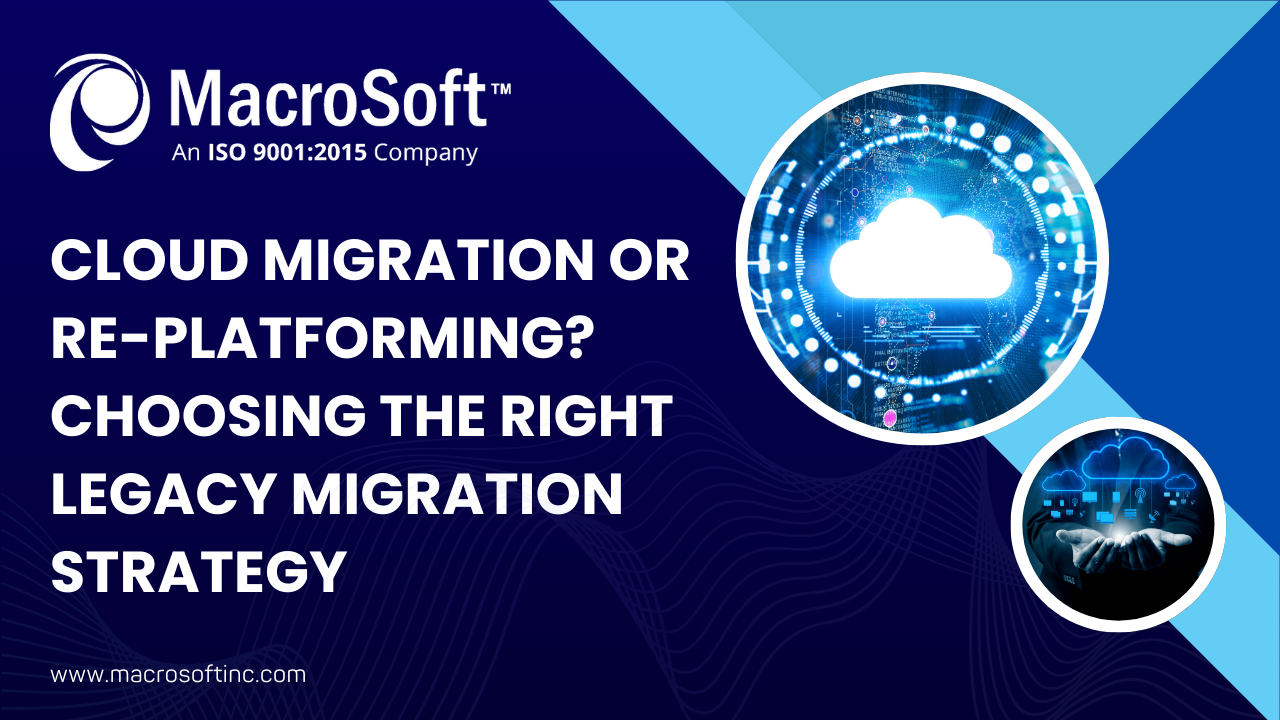
By Joe Rafanelli | Published on May 7th, 2025 | Last updated on June 13th, 2025 |
In the digital era, enterprises face increasing pressure to modernize their IT infrastructure. At the heart of this transformation is the challenge of migrating to the cloud—a crucial step in achieving greater agility, scalability, and cost-efficiency. However, navigating the myriad options for legacy system migration demands a clear understanding of the available strategies and their implications. Should you choose a straightforward Lift and Shift Migration, opt for the more involved Refactoring Migration Approach, or adopt a balanced Replatforming approach?
In this blog, Macrosoft explores these options and provides a comprehensive guide to help you choose the right migration pathway tailored to your business needs.
Legacy system migration refers to the process of moving an enterprise’s existing applications and workloads—often built on outdated technology stacks—from on-premises data centers or private clouds to modern public or hybrid cloud environments. This process is no longer optional; according to Gartner, over 85% of large enterprises have already initiated some form of cloud migration, recognizing that outdated legacy systems inhibit innovation, agility, and responsiveness.
Yet, simply shifting workloads without a thoughtful approach can trap businesses in costly, inefficient cloud environments. That is why a strategic cloud migration approach is critical.
This is the most straightforward method of migrating applications “as-is” to the cloud without changing the architecture or codebase. The primary aim is to quickly move workloads to reduce data center costs or meet urgent deadlines.
According to a 2023 McKinsey report, approximately 45% of early cloud migrations employed the lift-and-shift strategy, primarily to achieve quick cost relief and business continuity.
Refactoring (or re-architecting) involves redesigning portions or the entire application to leverage cloud-native services, such as microservices, serverless computing, and managed databases.
McKinsey’s analysis indicates companies that adopt refactoring can reduce operational costs by up to 30% and improve deployment frequency by 50%, but these benefits come with increased complexity during migration.
Replatforming sits between lift-and-shift and refactoring. It involves making optimizations such as switching middleware, updating databases, or containerizing applications without fully redesigning them.
AWS research highlights that replatforming reduces migration risks while unlocking up to 20% operational improvements compared to lift and shift.
Your legacy migration strategy should align with long-term business goals. Fast-moving startups may prioritize speed and cost, favoring lift and shift. Enterprises requiring high scalability and innovation might lean towards refactoring or replatforming.
Not all applications are equal. Critical, complex, or heavily customized apps may benefit from refactoring, while stable, non-critical workloads suit lift and shift. Macrosoft recommends conducting a detailed portfolio assessment to categorize applications by complexity, business priority, and cloud readiness.
A study by Forrester found that 60% of IT downtime is linked to troubleshooting a legacy system. Migration strategies that reduce dependencies on fragile legacy components help mitigate downtime risk during and after migration.
Beyond cost savings, the benefits of digital modernization—such as improved security, enhanced user experience, and faster innovation—should influence your cloud migration approach.
Refactoring requires higher investment and longer timelines, while lift and shift provides cost-effective quick wins. Replatforming offers a middle ground.
Choosing the optimal legacy migration strategy is essential to unlock the full potential of cloud computing. Whether you pursue a Lift and Shift Migration, Refactoring Migration Approach, or a Replatforming approach, Macrosoft’s deep expertise can help you navigate the complexities of moving a legacy application and realize the benefits of digital modernization.
We combine industry best practices, cutting-edge tools, and tailored migration frameworks to ensure your cloud journey is smooth, scalable, and successful. Contact us today to migrate your legacy application to a modernized platform.